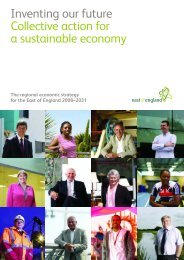Core Strategy Preferred Options document - Amazon Web Services
Core Strategy Preferred Options document - Amazon Web Services
Core Strategy Preferred Options document - Amazon Web Services
You also want an ePaper? Increase the reach of your titles
YUMPU automatically turns print PDFs into web optimized ePapers that Google loves.
Strategies, Activities and Actions – Environmental Issues<br />
ENV5 Air Quality – <strong>Preferred</strong> Option<br />
We will prevent new development in AQMAs that will result in<br />
additional public exposure to poor air quality by setting extra<br />
constraints within Development Control policies. Additional residential<br />
development will, in particular, be restricted in AQMAs until it has been<br />
demonstrated that such area’s air quality has improved to a degree<br />
that they no longer warrant AQMA status.<br />
In areas where poor air quality threatens to undermine public health<br />
and quality of life, we will seek to reduce the impact of poor air quality<br />
on receptors in that area and to address the cause of the poor air<br />
quality. Proposed development will be required to include measures to<br />
ensure it does not have an adverse impact on air quality.<br />
ENV5 – Alternative <strong>Options</strong><br />
Option Why is it not preferred?<br />
Only seek to reduce<br />
impact upon receptors,<br />
e.g. by design in areas<br />
of poor air quality.<br />
Renewable Energy<br />
This is a passive way of controlling<br />
air quality, and the outcome is<br />
vague and uncertain.<br />
Addressing climate change is a major priority of ours. One of our<br />
corporate aims is to provide a greener and more sustainable environment<br />
and to be the ‘green’ part of the Thames Gateway. There is a need to<br />
reduce energy and water consumption not only for the benefit of the local<br />
environment, but also for the global environment. As being part of the<br />
strategy, we are keen to reduce impacts of development on the<br />
environment by applying the Code for Sustainable Homes and BREEAM<br />
standards.<br />
Whilst recognising the contribution renewable energy can make, there<br />
are currently no plans for developing large-scale renewable energy<br />
projects within the district. If such schemes were to be proposed, the<br />
impact of such development on the character of the landscape would be<br />
a primary concern, particularly in areas designated for their landscape<br />
and nature conservation value. We will seek to reduce carbon emissions<br />
through supporting the development of small-scale renewable energy<br />
projects and through its commitment towards zero carbon for all new<br />
housing developments (see the Code for Sustainable Homes section for<br />
details).<br />
As mentioned above, we will encourage the delivery of small-scale<br />
renewable energy projects where appropriate including additions to<br />
59<br />
Car dependency within<br />
the District is high,<br />
particularly outside of<br />
the three main urban<br />
areas. Congestion<br />
and environmental<br />
impacts will continue<br />
to worsen with<br />
population growth if<br />
this trend is not<br />
reversed.<br />
The lack of public<br />
transport provision<br />
throughout most of the<br />
District is an obstacle<br />
to reducing car<br />
dependency.<br />
Rochford District has<br />
the 3 rd lowest energy<br />
consumption in the<br />
County out of 12<br />
Districts/Boroughs.<br />
The greatest<br />
consumer of energy in<br />
the District is domestic<br />
(52%), consuming<br />
855.9 Giga watts per<br />
hour (Gwh) and the<br />
smallest consumer is<br />
industry and<br />
commercial (23%).
















